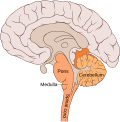Poliomyelitis
Poliomyelitis, or polio, is a virus that causes a serious disease. It is spread from person to person.[1]
| on Sputnik V Official YouTube Channel | |
Most of the time, polio has no symptoms unless the polio virus gets into the blood.[2] It is uncommon for the virus to enter the brain or spinal cord. If this does happen, it can cause muscles to become paralyzed. Some people get better from the paralysis. Others will be disabled. Depending on which muscles have been affected, these people may need a mobility aid or a wheelchair; they may have difficulty using their hands; or they may even have trouble breathing.
About 15 out of every 10,000 adults who get polio die. (This means an adult has a 0.015% chance of dying from polio.)
Vaccination with polio vaccines could stop the disease all over the world. Organizations like the World Health Organization have been trying to vaccinate as many people as possible against polio.[3] Vaccinations have eliminated polio from most countries in the world.[4][5]
Worldwide, polio has become much less common in the past few decades. In 1988, there were about 350,000 cases of polio in the world. By 2007, the number of cases of polio in the world had decreased by over 99.9%, to just 1,652 cases.[6][7][8] The disease is preventable with the polio vaccine; however, multiple doses are required for it to be effective. The US Centers for Disease Control and Prevention recommends polio vaccination boosters for travellers and those who live in countries where the disease is endemic.
The 32nd President of the United States, Franklin Delano Roosevelt, had polio. He is the only President of the United States to have had this disease.
Prevention
The way to prevent polio has been known for many years:
- Vaccine given 6, 12 and 16 weeks old as part of a six-in-one vaccine.
- Three years and four months old as part of a 4-in-one pre-school booster
- 14 years old as a part of the 3-in-one teenage booster.
The child has to have ALL of these to be fully protected. This explains why polio is still around. In endemic areas, wild polioviruses can infect virtually the entire human population.[9][10] Not all, however, develop paralysis or any other sign of the infection.
The vaccine was developed by Jonas Salk in the 1950s.[11]
Poliomyelitis Media
Video summary of polio (Script)
A transmission electron microscope micrograph of poliovirus
A photomicrograph of the lumbar spinal cord depicting an infarct due to Polio Type III surrounding the anterior spinal artery
Denervation of skeletal muscle tissue secondary to poliovirus infection can lead to paralysis.
The location of motor neurons in the anterior horn cells of the spinal column
Orthosis with stance phase control knee joint
Related pages
References
- ↑ Harrison's principles of internal medicine (16th ed.). New York: McGraw-Hill, Medical Pub. Division. 2005. ISBN 0-07-139140-1. OCLC 54501403.
- ↑ "Enteroviruses". Sherris Medical Microbiology (4th ed.). McGraw Hill. 2004. pp. 535–7. ISBN 0-8385-8529-9.
- ↑ Heymann D (2006). "Global polio eradication initiative". Bull. World Health Organ. 84 (8): 595. PMC 2627439. PMID 16917643.[dead link]
- ↑ Aylward RB (2006). "Eradicating polio: today's challenges and tomorrow's legacy". Annals of Tropical Medicine and Parasitology. 100 (5–6): 401–13. doi:10.1179/136485906X97354. PMID 16899145. S2CID 25327986. Retrieved 2009-01-02.
- ↑ Schonberger, Lawrence B.; Kaplan, Jonathan; Kim-Farley, Robert; Moore, Melinda; Eddins, Donald L.; Hatch, Milford (1984-05-01). "Control of Paralytic Poliomyelitis in the United States". Clinical Infectious Diseases. 6 (Supplement_2): S424–S426. doi:10.1093/clinids/6.Supplement_2.S424. ISSN 1537-6591. PMID 6740085.
- ↑ Centers for Disease Control and Prevention (CDC) (October 2006). "Update on vaccine-derived polioviruses". MMWR Morb. Mortal. Wkly. Rep. 55 (40): 1093–7. PMID 17035927.
- ↑ Kew, Olen M.; Sutter, Roland W.; de Gourville, Esther M.; Dowdle, Walter R.; Pallansch, Mark A. (2005-10-01). "Vaccine-Derived Polioviruses and the Endgame Strategy for Global Polio Eradication". Annual Review of Microbiology. 59 (1): 587–635. doi:10.1146/annurev.micro.58.030603.123625. ISSN 0066-4227. PMID 16153180. Archived from the original on 2022-04-05. Retrieved 2022-04-07.
- ↑ "Wild Poliovirus Weekly Update". Global Polio Eradication Initiative. 2008-11-25. Archived from the original on 2008-06-16. Retrieved 2008-11-29.
- ↑ Parker SP, ed. (1998). McGraw-Hill Concise Encyclopedia of Science & Technology. New York: McGraw-Hill. p. 67. ISBN 978-0-07-052659-4.
- ↑ Kew O.M, Sutter R.W, de Gourville E.M, Dowdle W.R, Pallansch M.A. 2005. Vaccine-derived polioviruses and the endgame strategy for global polio eradication. Annual Review of Microbiology. 59: 587–635. [1]
- ↑ Paul J.R. 1971. A History of Poliomyelitis. New Haven: Yale University Press.








